

The Role of Nutritional Support for Cancer Patients in Palliative Care. 1.
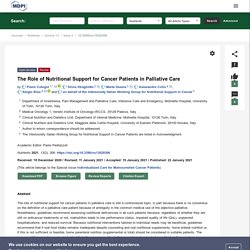
Introduction The role of nutritional support for cancer patients in palliative care is still a controversial topic. In the past, there has been limited collaboration between oncologists, clinical nutrition specialists, and palliative care physicians involved in the care of advanced cancer patients. Collaboration has been made more complex by the fact that, while it is clear what nutritional support is, there is no common or shared definition, not so much of palliative care, but of what constitutes a person who needs palliative care.
In fact, there is no consensus in the literature on the definition of the palliative care patient because of the ambiguity in the common use in medicine of the adjective palliative [1]. Palliative care was established in the United Kingdom 50 years ago [4]. American College of Sports Medicine Roundtable Report on Phy... : Medicine & Science in Sports & Exercise. It was estimated that 18.1 million individuals were diagnosed with cancer in 2018 and 9.6 million individuals died from the disease—making cancer the second leading cause of mortality worldwide (1).
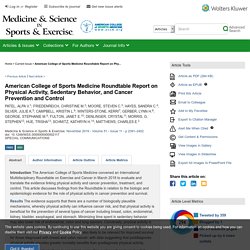
In the United States (US) alone, the lifetime risk of developing cancer is 40% in men and 38% in women (2), and 1.74 million individuals were diagnosed with cancer in 2018 (3). There are also high direct and indirect costs related to the cancer burden; for example, in the US alone, the annual cost of cancer care is US $158 billion (4), with billions of additional dollars lost to disability, lost work, and lost household productivity (5). Thus, the burden of cancer remains a significant public health issue worldwide, and there is an increasing need to understand how modifiable health behaviors like physical activity may help prevent and control cancer in the population.
Exercise is medicine in oncology: Engaging clinicians to help patients move through cancer - Schmitz - - CA: A Cancer Journal for Clinicians. Introduction Multiple US and international organizations have published exercise recommendations for patients living with and beyond cancer, including the American Cancer Society (ACS),1 the American College of Sports Medicine (ACSM),2 Exercise and Sports Science Australia,3 Cancer Care Ontario,4 and the Clinical Oncology Society of Australia.5 In March 2018, the ACSM convened a Second Roundtable on Exercise and Cancer Prevention and Control.
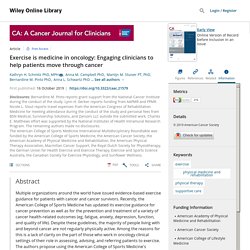
This second Roundtable included 17 organizations from multiple disciplines (see Supporting Table 1) and set out to review and update prior recommendations on cancer prevention and control. The products of this Roundtable include 3 articles. The first article from the 2018 ACSM Roundtable presents the evidence that exercise is associated with a lower risk of developing cancer and improved survival after a cancer diagnosis.6 A summary of the evidence from this review and the other recent reviews on this topic7, 8 is provided in Table 1. Nutritional Screening Tools Used and Validated for Cancer Patients: A Systematic Review: Nutrition and Cancer: Vol 71, No 6.
The purpose of this systematic review was to identify validated nutritional screening tools for cancer patients.
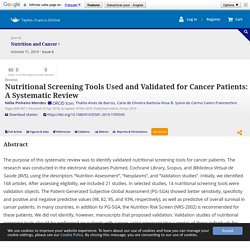
The research was conducted in the electronic databases Pubmed, Cochrane Library, Scopus, and Biblioteca Virtual de Saúde (BVS), using the descriptors “Nutrition Assessment”, “Neoplasms”, and “Validation studies”. Initially, we identified 168 articles. After assessing eligibility, we included 21 studies. In selected studies, 14 nutritional screening tools were validation objects. The Patient-Generated Subjective Global Assessment (PG-SGA) showed better sensitivity, specificity and positive and negative predictive values (98, 82, 95, and 93%, respectively), as well as predictive of overall survival in cancer patients. The Exercise and Sports Science Australia position statement: Exercise medicine in cancer management.
The emerging role of ketogenic diets in cancer treatment : Current Opinion in Clinical Nutrition & Metabolic Care. Diagnosis, assessment and management of constipation in advanced cancer: ESMO Clinical Practice Guidelines. Skip to Main Content Sign In Register Close Advanced Search Online ISSN 1569-8041 Print ISSN 0923-7534 Copyright © 2018 European Society for Medical Oncology.
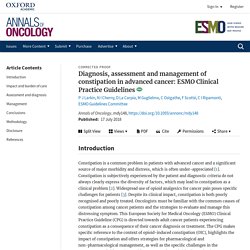
Clinical Oncology Society of Australia position statement on exercise in cancer care. Things We Do For No Reason: Neutropenic Diet. Nature, Nurture, and Cancer Risks: Genetic and Nutritional Contributions to Cancer. The role of the microbiome in cancer development and therapy. Abstract Answer questions and earn CME/CNE The human body harbors enormous numbers of microbiota that influence cancer susceptibility, in part through their prodigious metabolic capacity and their profound influence on immune cell function.
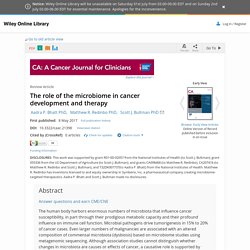
Microbial pathogens drive tumorigenesis in 15% to 20% of cancer cases. Even larger numbers of malignancies are associated with an altered composition of commensal microbiota (dysbiosis) based on microbiome studies using metagenomic sequencing. Although association studies cannot distinguish whether changes in microbiota are causes or effects of cancer, a causative role is supported by rigorously controlled preclinical studies using gnotobiotic mouse models colonized with one or more specific bacteria.
Practical Implications for Continuing Education Maintenance of microbial diversity is critical for human health. Introduction The Human Microbiome. NCCN Task Force Report: Bone Health in Cancer Care. Assessing Bone Health Osteoporosis and its associated increase in fracture risk is a major health issue for the aging population, and especially for patients with cancer.
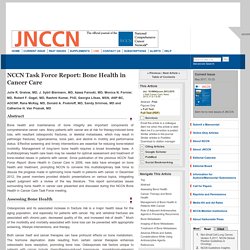
Hip and vertebral fractures are associated with chronic pain, decreased quality of life, and increased risk of death.1 Much of the morbidity and mortality associated with bone loss can be prevented with appropriate screening, lifestyle interventions, and therapy. Both cancer itself and cancer therapies can have profound effects on bone metabolism. The hormone deprivation state resulting from certain cancer therapies enhances osteoclastic bone resorption, promoting bone loss. Guidelines for perioperative care after radical cystectomy for bladder cancer: Enhanced Recovery After Surgery (ERAS®) society recommendations. 8.Epidural analgesia (EDA) 9.Minimally invasive approach Minimally invasive pelvic surgery has been shown to decrease the inflammatory response when compared to the open approach.

Laparoscopic rectal surgery seems to reduce the risk of postoperative ileus, complications and length of stay. However, long term oncological results are awaited before any higher LE statement can be drawn. Three prospective case series studies evaluated some form of minimally invasive approach to radical cystectomy. 10.Resection site drainage 11.Antimicrobial prophylaxis and skin preparation Regarding the optimal skin preparation, the ERAS recommendations in elective colorectal are of absolute value in cystectomy patients. 12.Standard anesthetic protocol Attention should be paid to maintain normoglycemia (possibly blood sugar less than 10 mmol/l), and adequate lung ventilation with low tidal volumes to limit peak airway pressure thus reducing the risk of barotrauma. 13.Perioperative fluid management. Cancer screening, prevention, and treatment in people with mental illness - Weinstein - 2015 - CA: A Cancer Journal for Clinicians. Abstract Answer questions and earn CME/CNE People with mental illness die decades earlier in the United States compared with the general population.

Most of this disparity is related to preventable and treatable chronic conditions, with many studies finding cancer as the second leading cause of death. Individual lifestyle factors, such as smoking or limited adherence to treatment, are often cited as highly significant issues in shaping risk among persons with mental illness. However, many contextual or systems-level factors exacerbate these individual factors and may fundamentally drive health disparities among people with mental illness.
Exercise for people with cancer: a clinical practice guideline. R.

Segal, MD*, C. Zwaal, MSc†, E. Green, RN‡, J.R. Tomasone, PhD§, A. Loblaw, MD MSc‖, T.